The Challenge
In the Midwest, a family-owned metal wall and roofing manufacturer was looking to grow their production capabilities whilst benefiting from local utility rebate programs.
Their existing operation was made up of three painting booths venting directly to the atmosphere. They planned to install two new paint booths as a part of the expansion, and pollution abatement equipment would have to be installed to accomplish this.
Their application brought about the below design challenges for the emission control solution required:
- Space was a huge concern, as the equipment had to fit in a tight space.
- The five paint booths represented a very large process stream containing volatile organic compounds (VOCs), including xylene, toluene, and ethylbenzene.
- They were looking to maximize energy rebates via their local utility provider, who provided prescriptive measures for the installation of pollution control equipment.
- The solution had to process up to 90,000 SCFM of VOC-laden air with a minimum of 95% overall destruction efficiency.
They requested proposals from a number of air pollution control equipment suppliers, including another Midwestern family-owned business, Anguil Environmental Systems.
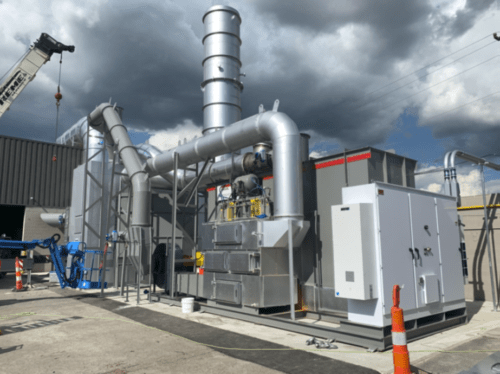
Image Credit: Anguil Environmental Systems
The Solution
Anguil engineers quickly identified the emission concentrator system as the most cost-effective choice due to such a big airflow from five paint booths and proposed a 90,000 SCFM Rotary Zeolite Emission Concentrator Wheel combined with a 7,500 SCFM Regenerative Thermal Oxidizer (RTO).
RTOs are extremely effective, efficient destruction devices, but they rely on a steady stream of process emissions to fuel the combustion of incoming contaminants. When coupled with a concentrator, the oxidizer is guaranteed to receive a consistent, highly concentrated stream in a much smaller volume.
At this flow rate, the choice of the concentrator is easy to justify when compared to a standalone 90,000 SCFM RTO with a similar footprint.
Although the capital cost of a concentrator and oxidizer combination is usually more costly than the single large RTO without concentration, the proposed system would utilize much less energy, dramatically reducing greenhouse gas emissions and operating costs.
The decrease in electricity and natural gas usage would also make the manufacturer eligible for energy rebates in their state.
For customers who implement energy efficiency measures, a rebate program is offered by their local utility company. Their current program has prescriptive measures for the installation of gas-fired equipment such as catalytic and thermal oxidizers.
The customer was eligible for a $37,500 rebate ($5.00/cfm for 2 shift operation x 7500 SCFM RTO) under this program.
As the concentrator system was even more efficient than a standard RTO, Anguil’s local sales representative approached the utility company engineers with the possibility of carrying out a custom energy analysis.
Anguil exhibited the energy consumption of the concentrator system and displayed it against a 90,000 SCFM RTO. This demonstrated that the concentrator system would utilize 771,450 kWh/ year ($0.05/kWH incentive) and 51,393.82 MCF of natural gas/year ($3.50/MCF incentive) which would result in a $218,000 rebate.
The utility company engineers proposed the project to an external consulting company that supplies oversight and regulatory compliance for the energy providers and their rebate programs. The consulting company agreed that the baseline should be a less thermally efficient style of thermal oxidizer, a recuperative oxidizer.
This catapulted the energy savings to 689,788 kWh electric and 209,094 MCF in natural gas savings for a total energy incentive of $766,319.00, but for natural gas payouts, there is a $300,000 cap per customer.
The Result
- The utility company decided to pay around half of the incentive for the program year 2020 and the balance in 2021 to accommodate their savings goal. This also removed the payout cap, so the customer received the full amount through both program years.
- Anguil secured the project and increased the customer’s total project rebate from an initial $37,500 to $300,000 with persistence and a strategic focus on maximizing the energy rebate program. This was an additional $262,500 savings.
- Anguil supplied ten days of start-up assistance and staff classroom training to ensure familiarity with their new state-of-the-art pollution control system as this was the customer’s first experience with emission control equipment.
In the past five years, Anguil has built more than 60 emission concentrator installations and is well-regarded as an industry leader with this technology. Anguil’s extensive experience with emission concentrators and successful advocacy for a significant custom energy savings program supplied the customer with confidence in their choice.
Anguil’s similarity to the customer’s Midwestern, family-run business also assured that they would be looked after and would enjoy project transparency and accessible communication.
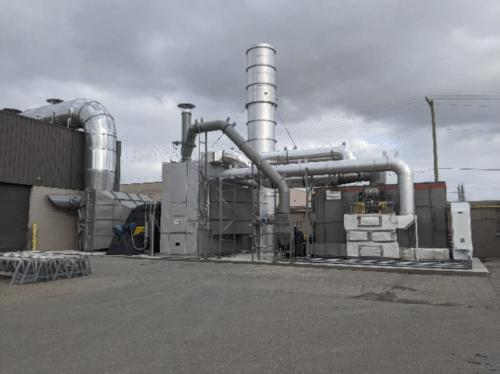
Image Credit: Anguil Environmental Systems
The Challenge
For the Coated Products Division of Brady Corp, the operating costs and emission control associated with meeting environmental regulations were nothing new. The company has been manufacturing coated films for over 70 years while showing a commitment to emission reduction and pollution prevention programs over that time.
When the Milwaukee coating facility decided to implement a new, energy-efficient emission control system, these considerations were magnified. The division maintains 200 different coating formulas on three main continuously operating process lines.
In order to enable the manufacturing of exceptionally clean products, two of the company’s three coaters work as so-called ‘white rooms.’ Solvent-based coatings with mixtures of chemicals are required for applying topcoats, adhesives, cast films, and other coatings onto a variety of substrates.
Some of the numerous solvents utilized in the process are:
- IPA
- Toluene
- Nitroethane
- MEK
- MIBK
- cyclohexanone
- 1,3-dioxolane
- Heptane
- Hexane
- nMP
- ethyl acetate
The dynamic process stream poses many challenges to the company, especially because it eliminates the option of solvent recovery.
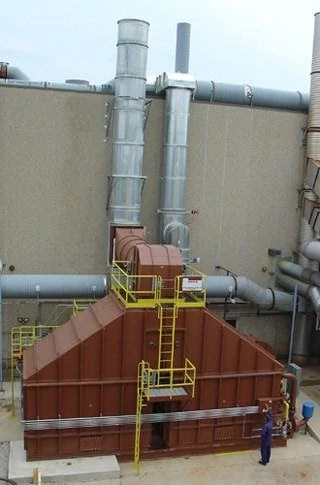
Image Credit: Anguil Environmental Systems
The Solution
The capital cost of emission control equipment can be rapidly eclipsed by operating expenses if careful consideration is not given to proper equipment selection. The company has focused on getting the most efficiency from its incineration equipment as natural gas prices are continuing to rise.
The facility has spent millions of dollars on air pollution control equipment since the early 1990s in order to meet a variety of EPA regulations imposed on coating companies.
The company has purchased a total of 13 combustion systems for the Milwaukee location alone, consisting of concentrator systems and thermal recuperative and regenerative thermal oxidizers (RTOs).
The oxidizers have been utilized to treat everything from low-point floor sweeps to coating emissions throughout the facility. The company looked for ways to reduce their yearly operating and maintenance costs as natural gas prices started rising in the late 1990s, and associated costs for emission control equipment steadily increased.
The maintenance and operating costs on older systems were overwhelming. It usually took more than a week to replace the cold face support grid and electric heating elements and then bring the unit back up to temperature when one of the old electric RTOs failed.
This happened so often that the maintenance department created a special tent so the repairs could be performed in the snow or rain.
A roller system was installed just to move the large duct transition, enabling access to weld the tube sheet without bringing in a crane as the thermal recuperative oxidizers on-site had so many issues with internal heat exchanger failure.
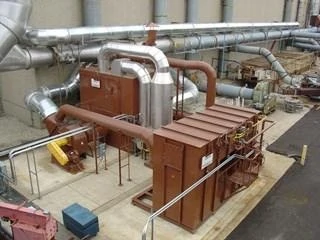
Image Credit: Anguil Environmental Systems
The Result
The decision to begin replacing the least efficient, oldest oxidizers was made, and the type of systems would be determined by the maintenance team.
The first phase of what plant personnel began to call its ‘efficient emission control plan’ would replace one of the thermal recuperative oxidizers with a 35,000 SCFM (56,175 Nm3/hr) RTO from Anguil Environmental Systems Inc.
The new two-chamber RTO was equipped with a hot-gas bypass that allowed it to process VOCs at rates up to 850 lbs/hour and tested out at a destruction efficiency rate of 99.2%.
Through a unique common manifold collection system, this high-capacity VOC processing enabled some of the other less efficient oxidizers to shift their load over to the new RTO.
Due to the concentration of hydrocarbons in the process air stream, the heat energy released from VOC combustion was enough to self-sustain temperatures for oxidation and did not require any additional fuel for operation.
RTO technology uses ceramic media as a high-efficiency heat exchanger in two or more beds. Process gas with VOC contaminants enters the RTO via an inlet manifold.
Flow diverter valves called poppets, divert gas into an energy recovery chamber that preheats the process stream. As they move toward the combustion chamber, the process gas and contaminants are heated progressively by the ceramic bed.
Next, the VOCs are oxidized, releasing energy which is transferred to the second ceramic bed to decrease any auxiliary fuel needed. So that the outlet gas temperature is only slightly higher than the inlet temperature, heat is transferred from the gas to the ceramic bed.
A flow diverter valve switches, alternating the ceramic beds so that over time each is in inlet and outlet modes. The energy released from their combustion promotes self-sustained operations if the process gas is made up of enough VOCs.
The maintenance team at Brady looked at a number of varieties of RTO systems, including a new rotary valve system. The rotary valves looked to be a good choice, but they were a close-tolerance proprietary item that could only come from the specific vendor.
The rotary valve location, which was underneath the RTO, also brought about major maintenance challenges. The company selected Anguil’s poppet valve design based on durability and serviceability.
The company was also happy that the RTO manufacturer offered to share its complete computer operating program, which was something other vendors were not willing to do. Some of the other items on the system included:
- Block-off plates after the system fan as needed for confined space entry
- A stairway for access to platforms instead of the usual vertical ladders, a feature appreciated especially in Wisconsin winters
- Heavier gauge access doors with fewer bolts to be removed
- Replaceable valve seats on the large access doors and poppet valves
The second stage of the plan was a bit more difficult but even more effective in decreasing the company’s operating costs. The EPA’s requirement for a permanent total enclosure, or PTE, meant that coaters had to create a negative pressure in all areas of the facility which processed solvents.
This became a large volume of exhaust air with very low VOC levels due to the layout of the coaters. Two of the old electric RTOs were treating this low-concentration, high-volume stream from wash-up areas, pump rooms, compounding areas, and floor sweeps located all around the facility.
In order to burn a very small amount of pollutants, large volumes of natural gas were being consumed. During plant shutdowns, the unit could not be turned off due to the time-consuming reheat procedure, which could last up to four days.
After assessing the solvent vapors and various concentrations, an Anguil Model 50 (5,000 SCFM, 8,025 Nm3/hr) RTO and Model 350 (35,000 SCFM, 56,175 Nm3/hr), rotor concentrator was chosen to handle this part of the process.
They were able to attain a 10-to-one concentration ratio by absorbing and concentrating the VOCs, which needed an oxidizer that was just a tenth the size to handle the concentrated process stream.
The energy contained in the concentrated stream entering the RTO was enough to enable self-sustaining operation, which needed little to no auxiliary fuel.
Subsequently they have ordered another 35,000 SCFM (56,175 Nm3/hr) RTO. The heat from the RTO will be utilized to preheat the facility’s ovens when this system has been installed to reduce energy consumption further. The system will have enough capacity to eliminate the final thermal recuperative unit and another aging electric RTO.
Careful consideration has been given to all the oxidizers as a single system, in addition to replacing old oxidation technologies at the facility. The company has implemented a dual collection and distribution manifold, which enables operators to divert process streams from one oxidizer to another for equipment shutdowns or maintenance.
For efficiency and reliability, the effect of these efforts has exceeded expectations. Gas usage on the company’s three coating lines has continued to decrease steadily. The reduction in energy consumption drops straight to the bottom line at a time when gas prices continue to rise, coupled with growth in production.
The company is continuing to investigate energy reduction strategies and is currently investigating the option of placing secondary heat exchangers on all of its oxidizers. The process would return waste heat to preheat the air streams on all of its other coating lines.
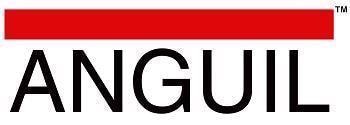
This information has been sourced, reviewed, and adapted from materials provided by Anguil Environmental Systems.
For more information on this source, please visit Anguil Environmental Systems.